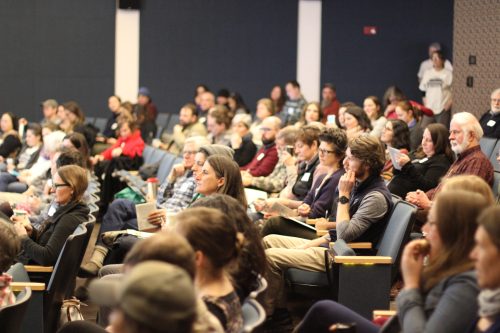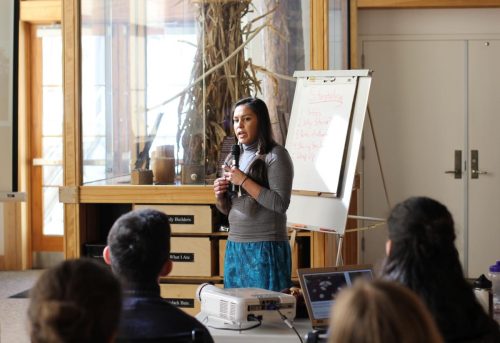As I waited in line for a mouth-watering local-food lunch of baked potatoes, butter, cheese, sour cream, ground beef, salsa and butternut squash soup and chatted with a colleague who lives nearly three hours from me, I found myself pondering a thought that has become a mantra for me throughout my six-year tenure at ANCA.
Food brings people together.
The act of sharing a meal is a communal bonding experience in every part of the world. Out of necessity, for pleasure and for social connection, we all eat.
However — what eats at me, besides blackflies and mosquitoes (get ready, spring is coming) — is that some of us face limited or uncertain access to adequate nutritious food. This condition is referred to as “food insecurity.”
Food insecurity — as well as the related economic pressures that prevent access to healthy, nutritious food — is a challenge encountered every day by over 40 million Americans, 12 million of whom are children.
The recent Regional Economic Analysis for the Adirondack North Country, published by ANCA and partners earlier this year, states that, “over 200,000 households in the region — 41% of all households — do not have enough income or wealth to afford basic household necessities.” According to Feeding America, over 142,000 people (11.4% of the population) in the North Country face food insecurity.
During this meal I’m joined by over 150 people interested in and working on food justice projects from various organizations and communities across the North Country and beyond. We’ve come together for the second annual Food Justice Summit at The Wild Center in Tupper Lake, NY.
Under the coordination of the North Country Food Justice Working Group, we’ve gathered to dig into a variety of topics ranging from storytelling to health, grassroots activism to state policy, farmworker justice to land access, and more.
You couldn’t imagine a more positive and engaged group coming together to face deep-rooted and systemic cycles of economic distress.
While enjoying the rich and relaxing flavors and aromas rising from this comfort food, I am surrounded by faces familiar and new. One of the youngest summit participants is only three months old — Baby James from Saranac Lake. James is our future, and his world is the one we’re working so hard to secure. To weave equity, inclusivity and collaboration into our region’s socio-economic tapestry — a fabric of which we’re all a part.
Resting on these values is ANCA’s approach to growing the region’s New Economy. And our vision for sustainable economic development and prosperity where economic health, community vitality and ecological stewardship are equally important outcomes. We are committed to creating opportunity for people with diverse backgrounds, experiences and education levels to change the trajectory of their collective future. Of our collective future.
How do we actually do that? We “cultivate action” — the theme of this year’s food summit.
Contributing to the energetic and positive conversation throughout the day, ANCA staff facilitated sessions on creative approaches to rural food access and farm to school/farm to institution.
Schools play a central role in our food system and our economy. Innovative schools are leveraging their community position and generational impact, exploring opportunities at the nexus of education, food, energy and health.
In terms of food, farm to school initiatives merit further investment and exploration. Food literacy is at the heart of empowering the next generation of consumers, a long-term impact that cannot be overstated. Yet, farm to school programs also create new markets for shorter-term economic impact and business development, helping disrupt systemic challenges for rural communities with new opportunities for prosperity, retention of youth and attraction of young families.
Working together, we can share best practices, tools and resources to inspire and support the creation of robust programs. Many sessions at the summit focused on inspiring stories of effective efforts towards food justice in the region — Adk Action’s Farmacy model, Families First local farm partnerships, the Joint Council for Economic Opportunity for Clinton and Franklin Counties (JCEO) and Healthy Heart Network’s mobile farmers market, and GardenShare’s food assistance programs, to name a few.
Though sustainable funding remains a challenge for some of these efforts, it’s clear that a multi-pronged solution, a collaborative “fork” of programming, is needed. The summit provides an opportunity for many different organizations to work together to identify steps towards long-term solutions that foster education, outreach and cultural shifts.
At the end of the day, these deep-rooted challenges are going to take tenacity and persistence to resolve. In fact, they may always lurk beneath the surface. With collaborative efforts like the Food Summit, we can continue to work together to identify new challenges as they come up and nip them in the bud.
As part of our commitment to action, collaboration and food justice, ANCA announced our annual FarmShare Fund mini grant program at the summit. This program is designed to promote a vibrant regional food system that is healthy for our communities, our farms and our environment. Funded projects improve access to affordable local food for everyone and support the livelihoods of our region’s farmers.
Want to get more involved? Check out the food justice map or contact us today to connect with people and organizations working on food security and food justice issues in the region. You too, can cultivate action in your community.
2019 Food Summit photos by Dan Rivera
